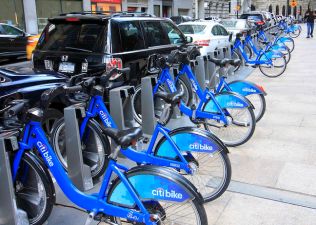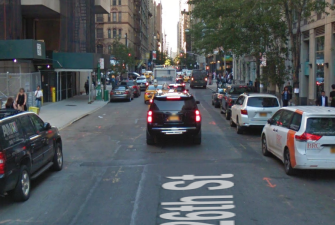Study: Bike-Share Has Boosted the Share of Female Riders in Manhattan
Bicycling in Manhattan has long been a male-dominated mode of transportation, but a new study says bike-share is helping improve the gender balance in the borough’s bike lanes. Another change since the blue bikes hit the streets last summer: Manhattan bike riders are far more likely to follow the rules of the road.

The Hunter College study [PDF], culled from observations of more than 4,000 cyclists at locations below 86th Street in Manhattan, showed that women account for 31.1 percent of Citi Bike riders, but comprised only 23.6 percent of other non-delivery cyclists. That’s still below the national average: In North America, about 43 percent of bike-share users are female, according to the League of American Bicyclists.
Another key finding verified what many New Yorkers could tell you by intuition: Citi Bike riders make up a larger share of bike ridership on avenues with protected bike lanes than on streets without them. Bike-share riders, the study says, are 32 percent of riders in protected bike lanes, but only 18.1 percent of cyclists on streets without a bike lane at all.
The study found that delivery cyclists made up 18.4 percent of cyclists on the road, while Citi Bike riders comprised 23.2 percent of all riders. All other types of recreational or transportation riders added up to 56.2 percent of people on bikes. (The survey takers could not classify 2.2 percent of cyclists.) The share of Citi Bike riders is slightly below a DOT count of the Citi Bike service area in August, which put the number at 29 percent.
The report comes from professors Peter Tuckel, a sociologist, and William Milczarski, an urban planner. (A previous study they authored on cyclist-on-pedestrian injuries drew fire from fellow Hunter College academics.) For this study, the professors had students observe 4,316 bicyclists age 14 and over at 98 different locations in Manhattan below 86th Street. Counts were performed between 7:30 a.m. and 8:30 p.m. from June 10 to November 1, though nearly three-quarters of the data was gathered in the final three weeks of October.
The professors led a similar study in 2009 [PDF], but its geographic range was smaller, covering the area from 14th to 59th Streets and excluding waterfront greenways. The authors made comparisons between the 2009 study and their new data by only looking at information collected within that zone.
They found that, in this smaller zone, a number of indicators about cyclist behavior had improved: The percentage riding against traffic decreased from 13.2 percent to 7.4 percent; the percentage of female riders was up from 9.5 percent to 18.5 percent; and the percentage of cyclists ignoring red lights dropped from 37 percent to 27 percent. The study did find that 12 percent of riders were using a phone or music player, up from 9 percent in 2009.
Helmet use rose dramatically, from 29.9 percent to 49.8 percent. Although two-thirds of Citi Bike riders rode without helmets, the vast majority of commercial cyclists — 73 percent — donned headwear.
The study’s conclusions are straightforward: “Predictions that the launch of the bike-share program would lead to a spike in the number of cycling-related injuries have not materialized. Citi Bike riders appear to be more cautious and even more compliant with traffic rules than other cyclists.”

